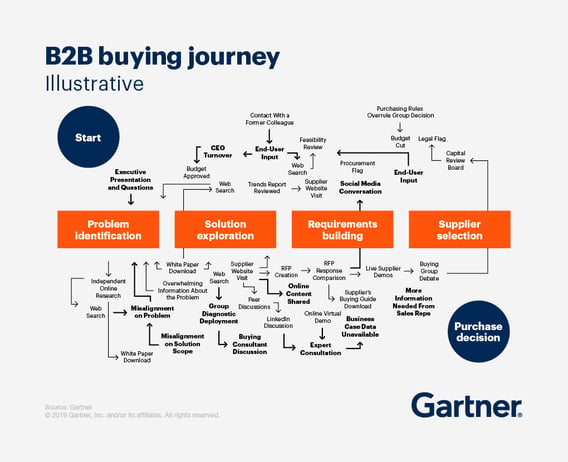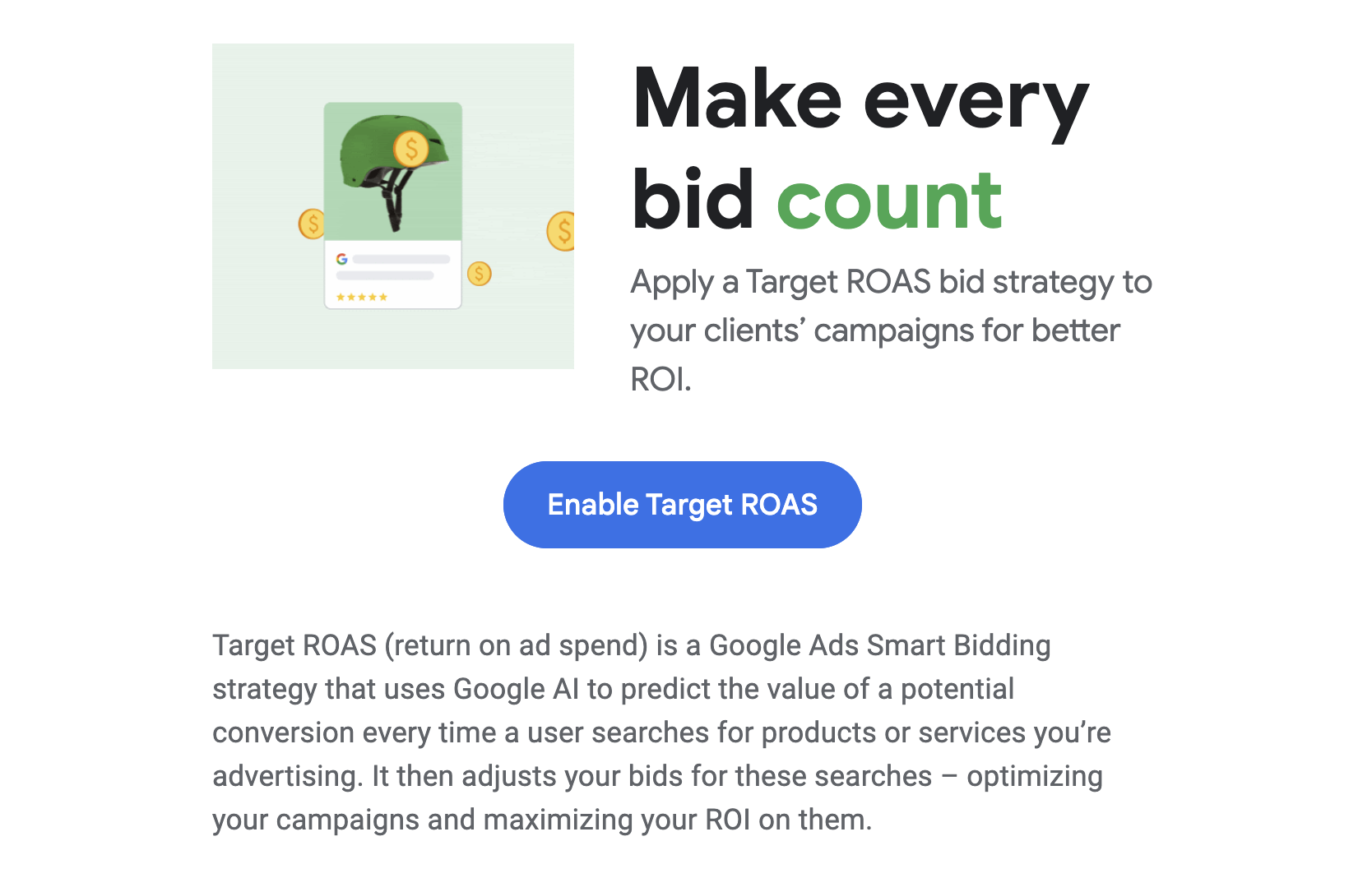Determining What Works
While marketing challenges are many, if practitioners could identify the specific elements that work, those that don’t, and quantify both at the discrete level, many other obstacles would evaporate.
Instead, many businesses chase marketing metrics that are a step removed from revenue: click-through rates (CTR), cost-per-click (CPC), cost-per-impression (CPM), etc. While these metrics help marketers manage spends, they tell the brand little about the revenue value of specific landing pages, ads, creatives, or journey paths. As a result, marketing optimization is based on weak or tangential data.
With the proper framework, multi-touch attribution (MTA) can tell marketers (and leadership) the return on all marketing efforts, from channel and campaign to specific landing pages, ads, and messaging. The resulting optimization opportunities can increase revenue, efficiencies, and market share.
Read more:
What is MTA?
Multi-touch attribution, or full-path attribution, quantifies the impact of marketing elements from channel to discrete marketing components and outputs the information in a way that is actionable for the brand.
The data must be made available to query and model a variety of brand-relevant questions to optimize marketing strategy and tactics for maximum return.
At its best, MTA captures user-event, marketing, sales data and meta-data, quantifies the value of each component and combination, and makes the results accessible so that the brand can activate the inherent value carried in brand-owned customer data. The result is a transformation when the potential value of data is activated with live prospects and customers to accelerate journeys, increase revenue, and maximize efficiencies.
Why MTA?
All marketers use some forms of measurement, even if only the ad platform’s built-in management or Google Analytics. Small brands or those using few channels may feel current measurement is doing all that is possible or necessary. However, the limitations of non-granular or single-touch attribution prohibit meaningful optimization.
For example, a company using only Google Ads may feel confident with automated bidding and placement, allowing Google’s machine learning to choose the best ad, the right bidding opportunity, and the right bid to achieve a specific cost per acquisition (CPA). However, ad platforms do not provide individual journey data. As a result, the business has no insight into optimum paths–or other channels. Built-in ad channel attribution offers little brand optimization control.
Benefits
Regardless of brand context and positioning, MTA provides multiple distinct advantages that increase capabilities and elevate brands.

the trouble is, I don’t know which half.”
-John Wanamaker
Measure Accurate Metrics
Whether ROAS, ROMI, LTV, or CPL, if revenue is not accurately attributed to specific marketing spends, the most powerful metrics are approximates for internal comparisons–not performance. For example, ROAS without attribution is simply a generic spend vs revenue metric that is specific to a channel at best, and surfaces no additional value about marketing element efficacy.
Allocate Costs Accurately
Multi-touch attribution reveals what works across the organization’s marketing and sales touches, from department-level spends, to initiative, and actual creatives. Attribution specificity allows accurate allocation of costs between initiatives, between sales and marketing, and actual ad creatives and messaging. By learning what works (and what doesn’t) across the organization, the entire business is accountable.
Close the Marketing Loop
Closed-loop marketing requires capturing and accurately connecting each lead, customer, and revenue transaction to the marketing components that enabled them. With MTA, these elements are captured at a granular level that allows true marketing and sales alignment.
Enhance a 360 View of Customers
The gold standard of customer relationships, the 360 view of a customer combines all customer information including purchase and brand interaction history, demographics, etc., all in a centralized source accessible to appropriate employees. However, combining a full-path MTA model with existing record data creates a powerful granular level of insights. When captured and accessible to key staff (marketing, sales, support), more brand interactions will be worthwhile to consumers and profitable for the company.
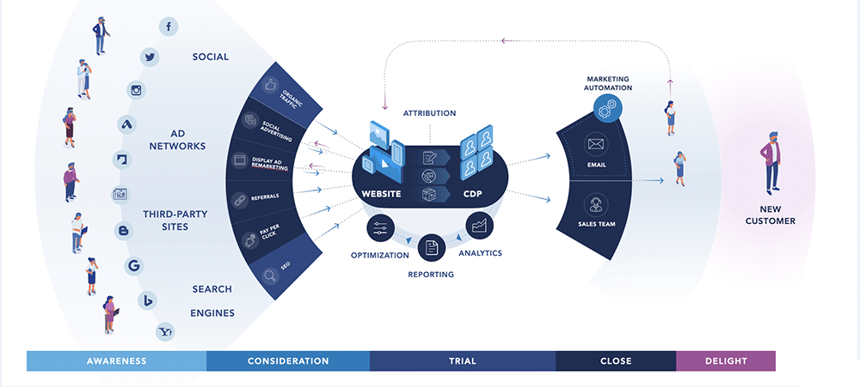
Understand the Customer Journey
With an increasingly complex customer journey, marketers need a method to capture and quantify the impact of each touchpoint as a prospect becomes a customer. Measuring individual and aggregate journeys reveals patterns that drive insights and optimization. Identifying how each touchpoint fits into larger buyer discovery, marketers can use trends to reveal accelerators and obstacles. Full-path MTA can uncover elements that move a visitor to become a lead, transition to an opportunity, and become a purchasing customer. When queried in alignment with cross-functional KPIs, this quantified journey can be applied to decrease CAC, refine messaging, and even optimize offerings.
Increase Revenue
With multi-touch attribution, marketers easily rebalance spends across channels, increasing effective spends and decreasing less effective spends. By calculating intersections of journey attributes and resulting transaction values, marketers can augment and refine across dimensions to drive revenue. Intelligence extracted from customer journey data can produce revenue faster. Calculating the costs of touchpoints and their conversion values, marketers can query multiple dimensions against the dataset to isolate revenue drivers and obstacles.
Increase Effectiveness
Using techniques such as Markov Chain to determine touchpoint probability and Shapley Value to determine contribution of each node in the journey, analysts can provide the business with the information necessary to architect measurably better performing customer journeys. By using conversion analysis, marketers can replace low-performing configurations with optimized ones, detect anomalies and streamline conversion paths.
Drivers
Quantifying marketing impact and understanding the customer journey are prerequisites for data-driven marketing decisions. Without such data, brands are using a shotgun approach to marketing spends, resource allocation, and sharing data to customer-facing teams. However, often pain points from the business environment drive the critical need for MTA solutions.
Complex Journeys
An explosion of channels, platforms, devices, and user-generated content has customers interacting in far greater volume and variety. What was once conceivable as a simplified linear flow is now often represented by scattered touchpoints across a hurricane of pathing options.
Complex Marketing Mix
Multiple ad networks, content marketing, and SEO all have significant resource commitments. And each demands allocation decisions based on far more data than channel-level revenue against monthly ad spends. Without touchpoint attribution data informing conversion analytics, complex marketing mixes become a large aggregate spend and return without decisioning information.
Maretc Expectations
Martec proliferation and costs drive expectations of significant return, much greater clarity in measurement understanding, and, in short, spend justification. However the market complexity outpaces actual martec implementation results. Many solution components are limited through either design or implementation. Moreover, even digitally-focused organizations are likely to underinvest in measurement.
Legacy Measurement
Established or legacy measurement practices are often not designed for the complexity and fluidity of consumer journeys today. Much of legacy measurement is built around single-channels, in organizational data silos, using dated processes, and even legacy systems that reinforce compartmentalization of measurement. As a result, widely used assessment methods fail to meet key goals:
Privacy Restrictions
Privacy-centric regulations and expectations are already undercutting third-party cookies and mobile ad identifiers, core components of many measurement models. While numerous performance-related reasons exist to transition from legacy approaches, organizations are slow to move away from even a complex, underperforming current state. However, the increasing privacy-focused environment upends existing practices and compels change.
Spend Justification
While often the first driver listed on MTA software landing pages, justification of spends is likely the least critical driver for investing in an MTA solution. Marketing cost centers often play defense. However, element-level ROMI not only accurately allocates department-level spends, it creates the insights needed for marketing optimization.
Together, these adoption drivers confronting current marketing departments and their brands create barriers to continue existing measurement approaches. Consequently, these challenges push brands to extend their impact with accurate true attribution–the ability to identify and quantify which marketing elements are creating value while surfacing a detailed understanding of the customer journey.
How MTA Works
To significantly increase revenue and efficiency, granular marketing data must be captured, transformed into a useful dataset, modeled and queried based on the unique brand KPIs and context, and activated by applying to marketing and sales activities.
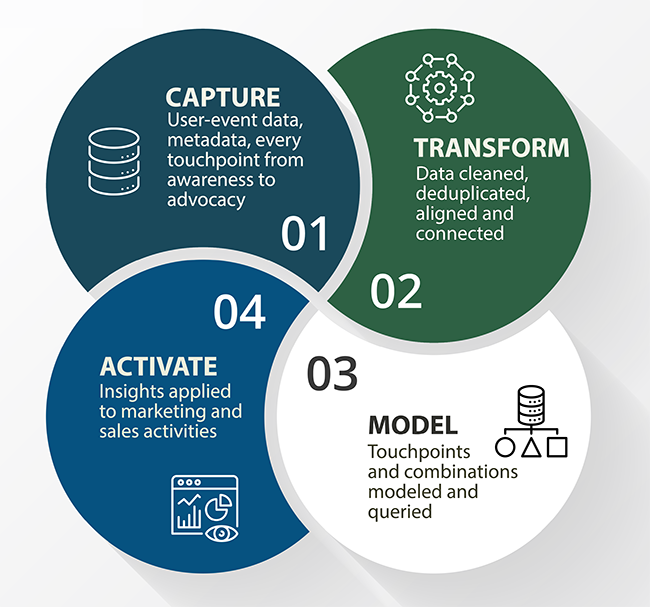 The MTA Framework
The MTA Framework
1. Data Capture
In order to activate full-path attribution and experience performance gains, a captured dataset must include all elements of the customer journey relevant to brand KPIs.
The core data centers on user-event data, i.e., data for every prospect and brand interaction. This data begins with user identifiers, marketing and sales touchpoints, spends and revenue. In order for the user-event data to be meaningful, appropriate metadata is also captured. For example, also captured are elements such as keyword, date, time, channel, campaign, ad group, ad, conversion, etc.
Data can be captured in multiple ways, including APIs, JavaScript, cookies, and custom scripts. Data can be stored in local servers, but often cloud warehouses are used to provide accessibility, security, affordability, and speed.
Brands that use single-touch models depend on many of the same data capture approaches, but with significant limitations. For example, businesses getting attribution data only from an ad platform will rarely capture multi-channel data, accessible granular customer journey data, or brand idiosyncratic data.
2. Data Transformation
Data from multiple systems and in multiple formats must be transformed into a user-friendly form before it can be modeled and queried. Data from a complex marketing mix requires standardization before activating it back into marketing performance. Transformation includes common data processes such as extraction, cleaning, normalizing, mapping, and integration.
In order to create accessible datasets, data must be extracted, cleansed, mapped, and integrated, with many processes beginning during capture and continuing after storage. For example, user-event data may be captured from the interaction in real time, and then metadata from an ad platform is connected during transformation. Cleaning, formatting, and standardizing data handles duplicates, missing values, reformatting, and validation. Finally, each platform or source uses a different data schema. The process defines relationships between data elements and maps them to a common schema. Once properly mapped, an automated system of queries and scripts can continuously pull, process, and load data into usable datasets for later modeling and queries.
Alternatives to multi-touch use a subset of transformation practices; however, since their purpose is more constrained in breadth (if not volume), the process excludes some elements from the full customer journey. For example, attribution using Google Analytics is contained within one brand’s ecosystem to a large degree. As a result, the attribution provider (Google) does not extract, clean, and standardize data from Facebook or LInkedIn, for example.
3. Model
The model and query phase is where insights are generated. This process allows marketers to view data through multiple lenses or models, and to query by various dimensions that underlie brand KPIs. The output of model views and queries answers key questions about the customer journey and its components.
Rule- and Position-Based MTA Models
Attribution models can include rules-based, data-driven or algorithmic. Rules-based models are applied to journeys with predetermined allocation values. For example, U-Shaped MTA models apply 40% of the conversion credit to the first touch or acquisition in the journey, 40% to the converting touchpoint, and 20% distributed to remaining touchpoints, providing limited insight into acquisition and conversion.

Multi-touch rules-based or position-based models include:
- Linear (credit is equally distributed across touchpoints)
- Time-Decay (applies more weight to touchpoints closest to conversion)
- U-Shaped (applies 40% each to first and last touchpoints, with 20% distributed to remaining touchpoints)
- W-Shaped (similar to U-Shaped, but applies 30% credit to first, last, and midpoint lead conversion touchpoints, with remaining touchpoints dividing 10%)

Data-Driven or Algorithmic Models
While rules-based models have specific uses, the preferred and more widely effective models are data driven or algorithmic. In these models, the context of the user-event is placed within the much larger body of existing customer-brand interaction data, and ideally processed with machine learning (ML). AI tools such as ML provide speed, accuracy, and insights unavailable with manual marketer practices.
Queries
Effective and accurate attribution with a full-path multi-touch dataset allows a business to query the dataset to gain insights into current and predictive KPIs. For example, an algorithmic MTA model can answer:
- What paths provide the highest transaction value?
- From which channel and touchpoints do the highest value customers originate?
- Which touchpoints are common to lowest customer acquisition costs (CACs)?
- In which channels and combinations are the highest non-working dollars found?
- What is the return if non-working dollars from X are moved to Y?
- What is the expected return on a specific sales channel for the next year?
Alternatively, single-touch models have a far more limited value, such as understanding customer acquisition (first touch) or converting touchpoints (last touch). As a result, the reduced dataset driving single-touch provides partial and misleading insights into key KPI questions.
Finally, models should be used as a way to view customer journeys and consider alternative paths, and not as a template universally applied to customer journeys. Overfitting models detracts or narrows from the marketer’s goal of answering different performance questions. Consequently, evolving algorithmic models and ongoing experimentation are the optimum methods for accurate attribution measurement and predictive analytics.
4. Activate
Once models and queries generate insights and understanding of the marketing and journey elements, brands are ready to activate their data into business processes.
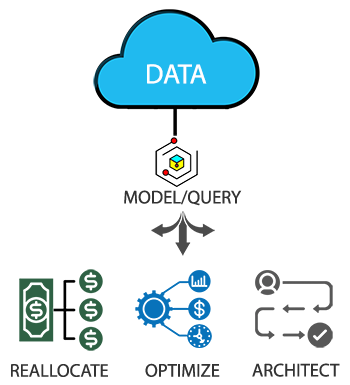
Now brands can begin to activate their data by applying the insights to increase performance. Often, even simple reallocation across channels can provide game-changing results. For example,when a brand calculates that an underutilized channel is performing twice as well as one currently over allocated, the ROI can be 100% or greater.
Next, elements of the customer journey and marketing mix can be optimized through discrete element changes to remove barriers or take advantage of untapped accelerators. For example, conversion and path analysis might reveal that a specific white paper is almost always followed by a successful opportunity. However, this sales accelerator (e.g., white paper) is accessible only from one channel. Reconfiguring the marketing mix to increase customer access could increase successful opportunities and revenue.
Finally, a detailed full-path analysis identifies those components with higher probabilities for creating sales at each point in the funnel. Using this information, brands can architect multiple journeys with greater probabilities than currently available to prospects. Taking the best top-of-funnel elements (top landing page, display ad, etc.), the greatest lead converters (interaction, pdf, etc.), and the top sales converters (promotion, discount, CTA, etc.), marketers can create end-to-end customer journeys that make high-value touchpoints more accessible throughout the customer path, increasing value at every user-event.
Once a model or set of queries are answered directly from the dataset, insights must be implemented into business strategy and tactics to activate the value inherent in a brand’s owned data.
Who Should Use MTA?
Fortunately, MTA is within reach of even small brands today. Traditional barriers such as accessible data volume, processing power, and data storage are no longer significant challenges to modern brands. Brands with significant online presence can access high-volume first-person data. Processing power for attribution algorithms is also no longer reserved for large organizations. Finally, online data storage is accessible, cost-effective, and secure.
Most barriers to increasing data-driven performance gains are within the hands of brand leadership.
- Unshackling from ad platform attribution limitations
- Upgrading from limited analytics platforms
- Understanding the MTA framework and viewing customer data through the appropriate models and queries to gain insights into brand KPIs
- Resolving to become a data-driven organization, where decisions are based on data and not solely the intuitive instinct of experience
Arcalea's Galileo is a full-path MTA solution that captures customer journey insights and revenue, unbiased by ad platforms or limited by partial analytics. Once a business begins using multi-touch attribution, data insights and market knowledge combine to create a unique competitive advantage.
What’s Next
If a brand is ready for transformation to a data-driven culture, then it’s ready for multi-touch attribution.
Start where Capability Exists
Multi-touch attribution is demanding, requiring a spectrum of KPI definition, the capture of exhaustive data points, and the configuring of data using critical dimensions and values. Marketing departments must begin where they are organizationally–not necessarily from a technical capability, for that can be offloaded. However, brands should ensure their data science maturity is capable of acting on the data.
Validate Goal, Strategy, and Tactics
Businesses should focus on the clear definition of business goals and strategy before overcommitting to specific measurement methodologies. Validate brand goal, strategy, and tactics for accuracy and alignment first. If analytics from any specific area call these fundamental definitions into question, companies can revisit fundamentals, offering attributes, and funnel back into product development teams. If a full analysis of Goals, Strategy, and Tactics (GST) has not been performed in the recent year, a GST assessment is likely overdue.
Test and Experiment
A culture of test and experiment surfaces opportunities that cannot be found through traditional measurement. Regardless of business and current measurement approaches, MTA should follow a test and learn approach with multiple models. Businesses should verify how models perform against specific metrics across all relevant dimensions.
Invest in Personnel
In addition to dedicated analyst positions, marketing should invest in higher capabilities, with measurement roles reporting to C-level. Visible changes at the top signify a culture shift in the importance of measurement and data science. Marketing teams should be more financial and data science knowledgeable. Lack of interpretive skills and framework knowledge limit marketing teams to software-only approaches and a dependency on agencies.
Find Responsive Partners
Marketers need agency partners who excel in marketing data analysis, partners who assist brands in defining data needs, capturing and transforming data at the right granular levels, and applying it to tests and large-scale implementations. As companies partner with transparent and flexible experts, the internal capabilities they build will bring brand strength to new data science maturity and performance expectations.
Selected Reading
Lau, Wilson, (2022). A Practical Guide to Multi-Touch Attribution. Search Engine Journal.
MMA (2021). MTA I Dead, Long Live MTA. MMA Global. (registration required)
Patel, Neil. Learning More About That Other Half: The Case for Cohort Analysis and Multi-Touch Attribution Analysis. Neil Patel blog.
Marketing Impact Demands Accurate Data
Accurate sales attribution results from strong user-event data. However, many companies do not capture data identifying key touchpoints. Use our Galileo platform to track all touchpoints, accelerate journeys, boost sales, and activate your data.
We'll maximize your competitive advantage.





